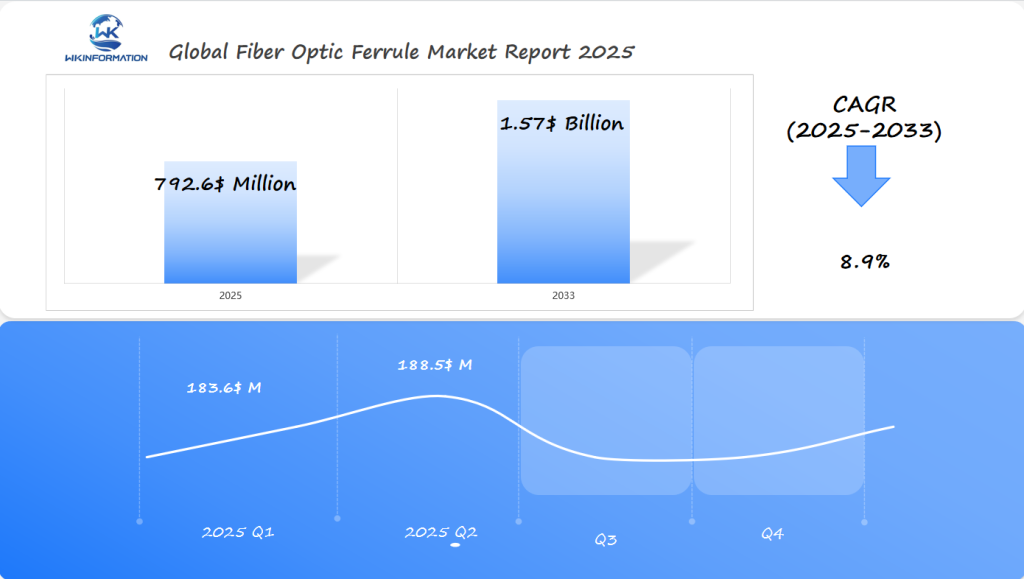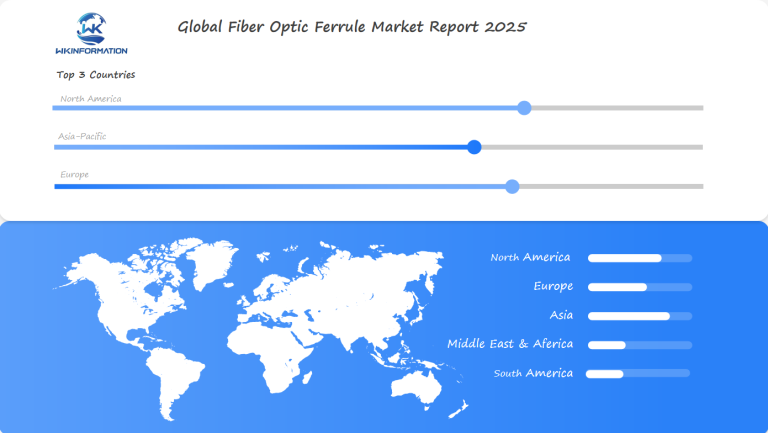Fiber Optic Ferrule Market in 2025 with $792.6 Million Growth Opportunities and Insights from the US, Japan, and India
- Last Updated:
Fiber Optic Ferrule Market Forecast for Q1 and Q2 of 2025
The global fiber optic ferrule market is valued at approximately USD 792.6 million in 2025 and is projected to grow at a CAGR of around 8.9% from 2025 to 2033. In Q1 2025, the market is expected to generate approximately USD 183.6 million, driven by the growing adoption of fiber optic technology in telecommunications, data centers, and broadband services. By Q2 2025, the market is projected to reach around USD 188.5 million, as demand for high-speed internet and robust network infrastructure continues to rise globally.
The US, Japan, and India are key regions to focus on within the fiber optic ferrule market. The US remains the largest market due to its high demand for fiber optic components in the expanding broadband and telecommunications sectors. Japan, with its emphasis on technological innovation and smart city projects, plays a crucial role in driving market growth. India, with its rapid urbanization and expanding digital infrastructure, is also witnessing a significant increase in demand for fiber optic solutions, boosting the market for fiber optic ferrules.

Upstream and Downstream Dynamics of the Fiber Optic Ferrule Market
Understanding the upstream manufacturing processes is crucial for grasping the dynamics of the fiber optic ferrule market. The production begins with precision molding techniques, often utilizing high-purity materials like zirconia ceramic due to its excellent thermal stability and mechanical strength. These materials are shaped into ferrules that ensure minimal signal loss during data transmission.
Key suppliers play a pivotal role in this supply chain. Companies specializing in raw material extraction and processing, such as Corning and Sumitomo Electric, provide the essential components needed for manufacturing. Their contributions ensure a steady flow of high-quality materials, which are then shaped into ferrules by manufacturers like Fujikura and Amphenol.
On the downstream side, these components find applications across several industries:
- Telecommunications companies utilize fiber optic ferrules within connectors to maintain efficient network infrastructures.
- Data centers rely on them for high-speed, reliable connections crucial for cloud computing services.
- Other end-users include sectors such as healthcare, where they enable advanced medical imaging technologies, and defense, requiring secure communication channels.
The intricate interplay between upstream production and downstream applications highlights how each segment of the supply chain drives the market forward. As technology advances, these dynamics evolve to meet new demands, ensuring continual growth in the fiber optic ferrule market.
Key Trends Shaping the Fiber Optic Ferrule Market in 2025
The fiber optic ferrule market is undergoing significant changes due to important technological advancements. Two major trends driving this transformation are:
- The impact of 5G technology: The introduction of 5G networks requires extremely fast and reliable data transmission. Fiber optic ferrules play a crucial role in achieving this by ensuring precise alignment and minimal signal loss in fiber optic connectors. As 5G infrastructure continues to grow worldwide, the demand for these components is expected to increase significantly.
- The adoption of cloud computing and data centers: These facilities rely on high-speed data transmission solutions to efficiently manage large amounts of information. Fiber optics, known for their ability to handle high bandwidths and long-distance data transfers without degradation, are becoming the preferred choice. This directly affects the fiber optic ferrule market as service providers upgrade their infrastructure to accommodate rising data traffic.
These trends indicate a shift towards more advanced communication systems and highlight the importance of fiber optic ferrules in supporting modern digital connectivity across various industries.
Challenges and Restrictions Impacting the Fiber Optic Ferrule Market
The Fiber Optic Ferrule Market faces significant challenges that could impact its growth trajectory. One of the primary concerns is the high manufacturing costs associated with producing these components. The intricate nature of fiber optic ferrules requires advanced technology and materials, resulting in substantial expenses. These costs can hinder profitability, especially for smaller firms trying to enter the market.
Another critical challenge is the need for stringent precision requirements during production processes. Ferrules must ensure precise alignment of optical fibers to minimize signal loss, necessitating highly accurate manufacturing techniques. This demand for precision limits scalability, as only specialized facilities equipped with state-of-the-art technology can meet these exacting standards.
These challenges create market barriers that can deter new entrants and restrict expansion efforts. Companies must invest heavily in research and development to innovate cost-effective production methods while maintaining quality. Despite these obstacles, technological advancements and strategic partnerships may offer potential solutions to overcome these hurdles.
Understanding and addressing these challenges is crucial for stakeholders aiming to thrive in the competitive landscape of fiber optic ferrules. This sector’s success hinges on balancing innovation with cost management to address these pressing issues effectively.

Geopolitical Influence on the Fiber Optic Ferrule Market
Geopolitical factors play a significant role in shaping the landscape of the fiber optic ferrule market. As global supply chains become increasingly interconnected, international trade policies directly impact the availability and cost of materials required for manufacturing these components.
Key Geopolitical Influences
- Trade Policies: The imposition of tariffs and export restrictions can lead to increased costs and supply chain disruptions. Countries with stringent trade policies may hinder the flow of raw materials, affecting production timelines and pricing structures.
- Geopolitical Tensions: Regional conflicts or diplomatic disagreements can also alter market dynamics. For instance, tensions between major economies may lead to protective measures or sanctions, impacting cross-border collaborations and investments in fiber optic infrastructure.
Strategic Implications for Businesses
These geopolitical influences necessitate strategic planning by companies operating within the fiber optic ferrule sector. Businesses must remain adaptable, navigating complex international landscapes to ensure resilient supply chains and sustained growth. As geopolitical climates shift, staying informed on policy changes becomes crucial for maintaining a competitive edge in this rapidly evolving market.
Segmentation Breakdown of the Fiber Optic Ferrule Market
The fiber optic ferrule market is segmented based on several factors, including material type, application, and end-user industries. Key segments include:
-
Material Type: Fiber optic ferrules are primarily made of ceramics, stainless steel, and plastic. Ceramic ferrules dominate the market due to their high durability, low thermal expansion, and precision. Stainless steel and plastic ferrules are also gaining traction for certain cost-sensitive applications.
-
Application: The primary applications of fiber optic ferrules are in telecommunications, networking, data centers, and industrial sectors. These ferrules ensure the precise alignment of optical fibers in connectors, which is crucial for minimizing signal loss.
-
End-User Industries: Telecommunications, automotive, IT & networking, and military & defense sectors are major end-users. The telecommunications sector, in particular, is driving significant demand due to the rise of high-speed internet and 5G infrastructure.
Applications of Fiber Optic Ferrules in Telecommunications and Networking
Fiber optic ferrules play a crucial role in telecommunications and networking applications by facilitating the precise alignment and connection of optical fibers in connectors. These ferrules are vital in maintaining signal integrity and minimizing loss in high-speed communication systems.
In telecommunications, fiber optic ferrules are used in optical networks, including both long-distance communication and local area networks (LANs). As demand for high-bandwidth applications grows, especially with the expansion of 5G networks, the need for high-quality fiber optic ferrules has surged.
In networking, ferrules are essential components in data centers, where they are used in optical transceivers, routers, and switches to ensure seamless data transmission. The rising demand for cloud computing, big data, and real-time communications is further driving the need for reliable fiber optic ferrules to support the infrastructure of modern networks.
Global Trends and Regional Insights on Fiber Optic Ferrule Market Growth
Globally, the fiber optic ferrule market is witnessing significant growth, driven by the expansion of fiber optic networks, especially in high-bandwidth applications such as 5G, broadband internet, and cloud computing. The trend toward the digitization of industries and the increasing reliance on high-speed communication networks are key drivers of market expansion.
-
North America: Strong demand for fiber optic ferrules in telecommunications, data centers, and government infrastructure projects is expected to sustain growth. The rise of 5G and advancements in networking technology are fueling market opportunities.
-
Europe: Growing investments in smart cities and telecommunications networks, along with increased internet penetration, are creating demand for fiber optic components, including ferrules.
-
Asia-Pacific: The APAC region is poised to dominate the market due to the expansion of broadband infrastructure, particularly in China, India, and Japan, along with investments in 5G networks and data centers.

U.S. Fiber Optic Ferrule Market Trends and Developments
In the U.S., the fiber optic ferrule market is growing rapidly, driven by the expansion of 5G infrastructure, telecommunications, and data center construction. As demand for faster internet speeds and reliable connectivity grows, fiber optic components like ferrules are crucial to supporting the deployment of optical networks.
Key developments include advancements in ferrule materials and designs that improve performance and reduce signal loss. Additionally, there is a push toward integrating ferrules into more compact and cost-effective solutions to support growing market demands. The U.S. government’s investment in broadband infrastructure is further driving demand for fiber optic components.
Japan’s Role in the Fiber Optic Ferrule Market
Japan plays a significant role in the global fiber optic ferrule market, owing to its strong telecommunications and electronics industries. The country has long been a leader in fiber optic technology, and its demand for fiber optic ferrules is driven by the continuous expansion of high-speed internet infrastructure, 5G deployment, and advanced networking systems.
Japan is also a hub for innovation in materials used for fiber optic ferrules, with significant advancements in ceramic ferrules being developed to enhance precision, durability, and performance. Japan’s investments in research and development further contribute to the country’s position in the global fiber optic ferrule market.
India’s Contribution to the Fiber Optic Ferrule Market
India is increasingly becoming a major player in the fiber optic ferrule market due to the country’s rapidly expanding telecommunications network and broadband infrastructure. The Indian government’s initiatives, such as Digital India, are driving the growth of fiber optic networks and increasing demand for components like ferrules.
In addition to the telecommunications sector, India’s growing data center market is a key driver of demand. As the country continues to digitize its economy and increase internet penetration, the need for efficient, high-quality fiber optic components is expected to rise. Furthermore, India is becoming an important manufacturing hub for fiber optic components, which will likely drive the market further in the region.
Future Prospects for Fiber Optic Ferrules Beyond 2025
The Fiber Optic Ferrule Market is expected to grow significantly after 2025, thanks to ongoing technological advancements and the increasing need for high-speed internet access. Several key factors are driving this growth:
1. Innovations in Material Science
Manufacturers are constantly looking for new materials to make fiber optic ferrules stronger and more efficient. Innovations such as advanced ceramics and composites have the potential to transform the industry. These developments are expected to lower production costs while enhancing performance, making fiber optic solutions more affordable across different industries.
2. Emergence of Smart Cities
Smart city projects around the world will likely increase the demand for reliable fiber optic networks. Urban areas are increasingly depending on interconnected systems for managing traffic, ensuring public safety, and promoting energy efficiency. In such scenarios, having a robust fiber optic infrastructure becomes absolutely necessary.
3. Global Digital Transformation
Businesses and governments are actively pursuing digital transformation initiatives, which means there will be a greater reliance on data centers and cloud computing. This trend directly translates into a higher demand for efficient data transmission solutions like top-quality fiber optic ferrules.
Projected growth rates indicate that these factors could lead to an annual growth rate exceeding current expectations—potentially surpassing 10% each year as we move further into the next decade. The ongoing changes in telecommunications and industrial sectors point towards a bright future based on current trends and anticipated innovations shaping the industry.
Competitive Landscape in the Fiber Optic Ferrule Market
Key Players:
-
Chaozhou Three-Circle —— China
-
FOXCONN —— Taiwan
-
T&S Communications —— USA
-
Kyocera —— Japan
-
Adamant —— Japan
-
Kunshan Ensure —— China
-
BO LAI TE —— China
-
Thorlabs —— USA
-
SEIKOH GIKEN —— Japan
-
JC COM —— Japan
Overall
| Report Metric | Details |
|---|---|
| Report Name | Global Fiber Optic Ferrule Market Report |
| Base Year | 2024 |
| Segment by Type |
|
| Segment by Application |
|
| Geographies Covered |
|
| Forecast units | USD million in value |
| Report coverage | Revenue and volume forecast, company share, competitive landscape, growth factors and trends |
The Fiber Optic Ferrule Market is set for significant growth, driven by technological advancements and increasing global demand for high-speed data transmission. As the market moves towards an expected value of $1.57 billion by 2033, stakeholders must stay alert to the changing landscape.
For stakeholders, understanding these factors is crucial for navigating the future direction of this sector. Engaging with our Wkinformation Research report offers deeper insights and strategic considerations essential for anyone invested in the Fiber Optic Ferrule Market.
Global Fiber Optic Ferrule Market Report (Can Read by Free sample) – Table of Contents
Chapter 1: Fiber Optic Ferrule Market Analysis Overview
- Competitive Forces Analysis (Porter’s Five Forces)
- Strategic Growth Assessment (Ansoff Matrix)
- Industry Value Chain Insights
- Regional Trends and Key Market Drivers
- Fiber Optic Ferrule Market Segmentation Overview
Chapter 2: Competitive Landscape
- Global Fiber Optic Ferruleplayers and Regional Insights
- Key Players and Market Share Analysis
- Sales Trends of Leading Companies
- Year-on-Year Performance Insights
- Competitive Strategies and Market Positioning
- Key Differentiators and Strategic Moves
Chapter 3: Fiber Optic Ferrule Market Segmentation Analysis
- Key Data and Visual Insights
- Trends, Growth Rates, and Drivers
- Segment Dynamics and Insights
- Detailed Market Analysis by Segment
Chapter 4: Regional Market Performance
- Consumer Trends by Region
- Historical Data and Growth Forecasts
- Regional Growth Factors
- Economic, Demographic, and Technological Impacts
- Challenges and Opportunities in Key Regions
- Regional Trends and Market Shifts
- Key Cities and High-Demand Areas
Chapter 5: Fiber Optic Ferrule Emerging and Untapped Markets
- Growth Potential in Secondary Regions
- Trends, Challenges, and Opportunities
Chapter 6: Product and Application Segmentation
- Product Types and Innovation Trends
- Application-Based Market Insights
Chapter 7: Fiber Optic Ferrule Consumer Insights
- Demographics and Buying Behaviors
- Target Audience Profiles
Chapter 8: Key Findings and Recommendations
- Summary of Fiber Optic Ferrule Market Insights
- Actionable Recommendations for Stakeholders

Access the study in MULTIPLEFORMATS
Didn’t find what you’re looking for?
TALK TO OUR ANALYST TEAM
Need something within your budget?
NO WORRIES! WE GOT YOU COVERED!
Call us on: +1-866-739-3133
Email: infor@wkinformation.com
What is the current valuation of the fiber optic ferrule market and what are its projections for 2025?
The fiber optic ferrule market is currently valued at a significant amount, with projections indicating robust growth by 2025. Key regions such as the US, Japan, and India are pivotal in driving this growth.
What are the main manufacturing processes involved in producing fiber optic ferrules?
The manufacturing processes for fiber optic ferrules involve precision engineering to ensure high-quality production. These processes include molding, machining, and assembly, which are crucial for maintaining the performance standards required in modern communication systems.
How is 5G technology influencing the fiber optic ferrule market?
5G technology is expected to have a substantial impact on the fiber optic ferrule market by increasing demand for high-speed data transmission solutions. This advancement necessitates more efficient and reliable components, thereby driving market growth.
What challenges does the fiber optic ferrule market face regarding manufacturing costs?
High manufacturing costs pose significant challenges to profitability within the fiber optic ferrule sector. Additionally, stringent precision requirements for production can limit scalability and increase operational expenses.
How do geopolitical factors affect the fiber optic ferrule market?
Geopolitical factors play a crucial role in shaping the dynamics of the fiber optic ferrule market. International trade policies and geopolitical tensions can disrupt global supply chains and influence market stability across different regions.
What types of fiber optic ferrules are available and what industries do they serve?
Fiber optic ferrules are primarily categorized into ceramic and plastic types. These components serve various end-user industries including telecommunications and healthcare, each benefiting from their specific applications in data transmission and connectivity.

